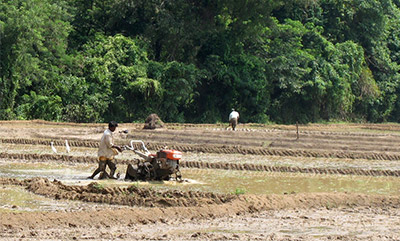AgMIP Global Gridded Crop Model paper published in PNAS
Dec 16, 2013
Global Gridded Crop Model Intercomparison predicts strong negative effects on agriculture from climate change – Effects strongest in developing countries
Agriculture is arguably the sector most affected by climate change, but assessments differ and thus are difficult to compare. As the world’s population grows, understanding which crop types and regions will be negatively affected by climate change may make the difference between adequate food supply and food insecurity. By comparing the predictions of multiple models, scientists can assess with more confidence future climatic effects on agricultural production.
The recently released paper, “Assessing agricultural risks of climate change in the 21st century in a global gridded crop model intercomparison,” led by Cynthia Rosenzweig, Senior Research Scientist at the NASA Goddard Institute for Space Studies, in the Proceedings of the National Academy of Sciences of the United States of America December 17, 2013, compares seven global gridded crop models in order to quantify the global effects of climate change on major crops.

The study, coordinated by the Agricultural Model Intercomparison and Improvement Project (AgMIP) as part of the Inter-Sectoral Impact Model Intercomparison Project (ISI-MIP) and led out of Columbia University and the NASA Goddard Institute for Space Studies included modeling teams from University of Chicago, Potsdam Institute for Climate Impacts Research, University of East Anglia, Karlsruhe Institute of Technology, Swiss Federal Institute of Aquatic Science and Technology, International Institute for Applied Systems Analysis/University of Natural Resources and Life Sciences, and PBL Netherlands. It is the first of its kind to compare multiple global gridded crop models in order to improve the quality of global agricultural assessments.
The paper presents globally consistent, protocol-based, multi-model climate change assessments for wheat, rice, corn, and soybean. Included in the study is the level of confidence, or how much uncertainty, is associated with the assessments. Results indicate strong negative effects from climate change, especially in the tropics and at higher levels of warming where developing countries are concentrated. Simulations that include realistic nitrogen availability resulted in much more severe impacts from climate change in both temperate and tropical zones. This implies that developing countries, where nitrogen fertilization is low, will have greater challenges in developing effective adaptation strategies.
Lead author Cynthia Rosenzweig and AgMIP Co-PI commented, “This is the first-ever global multi-model assessment for agriculture. AgMIP is advancing the science of climate change impacts, and decision-makers can now have greater confidence in results showing strong negative impacts on crop yields in developing countries.”
Although there is significant agreement in the models in the lower-latitude tropics and high-latitude zones, the mid-latitude temperate zones have a higher degree of disagreement or uncertainty. In the regions where the models agree researchers have greater confidence in the predictions and these can be used to formulate adaptive strategies. Further work is needed to improve the crop models so that the effects of CO2, nitrogen, and high-temperatures on agricultural production can be better understood to develop future policy.
Access the article here on the PNAS website.
